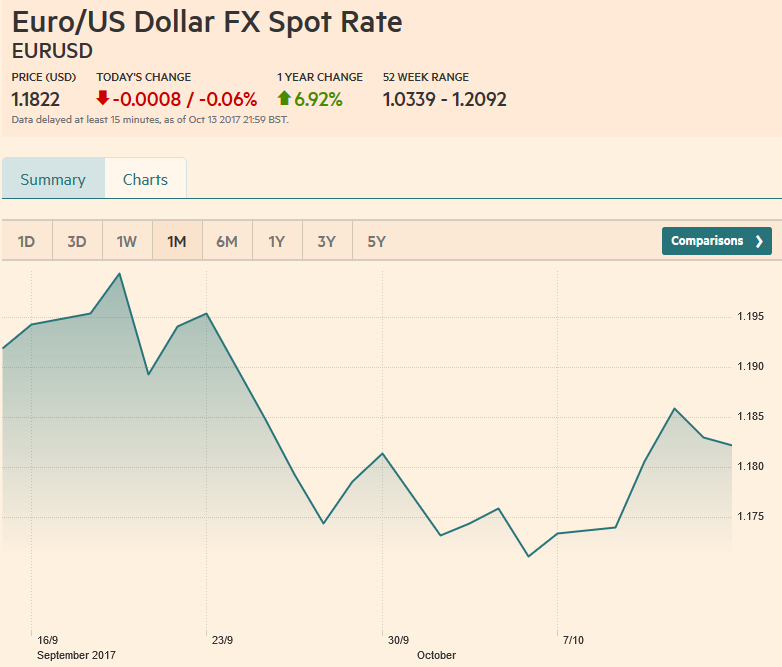There was a huge sigh of relief among investors when it became clear that the populist-nationalist wave that ostensibly led to Brexit and Trump’s election was not going to sweep through Europe. The euro gapped higher on April 24, and it has not looked back. We have suggested that with the outcome of the German election, European politics shift from tailwind to headwind.
Spain’s most serious constitutional crisis in 40 years appears to have climaxed this week. The business and political elite came together to resist the secessionist pull of Catalonia. Other European countries, including Germany and France, as well as the EU, defended the territorial integrity of Spain. Although the crisis may linger into next week, Spain’s assets began recouping some of their recent underperformance.
The political focus is already shifting within the eurozone. In Italy, the Chamber of Deputies finished today its third vote on the electoral reform. The bill now goes to the Senate, which is unlikely to take it up for several weeks. Next year’s budget is a more pressing issue. Still, the Senate is likely to approve the bill before the end of the year. While this makes possible an election at the end of Q1, we suspect it will be a Q2 event.
The new electoral rules favor coalitions, and this was immediately seen as a setback for the Five-Star Movement, which had ruled out forming a coalition. Recent polls showed the Five-Star Movement running neck-to-neck with the center-left PD. There are suspicions in some circles that Berlusconi’s forces may have struck a grand bargain with the Renzi’s PD that could involve not only the electoral law, but the budget, appointments to some state-run companies, and other issues. There seems to be some risk that no coalition or block will secure a majority, which would leave the situation not too dissimilar from the present.
Austria goes to the polls on Sunday. It may result in the first European government to include the populist-nationalists. There is an extenuating circumstance. The populist-nationalist Freedom Party served in government 2000-2006 (and was ostracized by other European countries). The center-right People’s Party new leader Kurz (31 years old) has shifted to the right, trying to outflank the Freedom Party on migration and response to Islam. A columnist at the Financial Times compared Kurz to conservative Austrian version of France’s Macron.
The People’s Party is drawing a solid third of the voters according to recent polls, and the Freedom Party is in second place with a little more than a quarter of the vote. The Social Democrats, which won the most votes four years ago, is in third place with a little more than 20%. Although Kurz was in government for six years, he has succeeded in running as an outsider, forcing the Social Democrats to be identified with the status quo.
Social Democrat Chancellor Kern did himself and his party few favors with the splintering of the party over the actions of a former adviser (Silberstein). Under Kern, the Social Democrats approved the Berka ban earlier this year. The full-face veil, ironically, is not typically worn by women in the countries from which the refugees in Austria typically come.
The Austrian election is important for more than another data point in European political theme. In the second half of next year, an important juncture of Brexit and post-crisis European evolution, and preparing for 2019 when Draghi’s term at the ECB ends, Austria takes up the mantle of the rotating EU presidency.
| While politics helps shape the policy framework, which in turn informs the investment climate, the euro continues to prove fairly resilient to the shifting political winds. The single currency has also been resilient to the widening two-year interest rate differential with the US. Germany’s discount is over 220 bp, which is within two basis points to the peak from March, which itself was the highest since 2000. A year ago, speculators at the IMM were net short around 100k euro futures contracts. Now they are net long 91k contracts. Implied volatility is about one percentage point lower (three-month implied vol is now near 7.2%). The one-year risk reversal (skew between puts and calls) favor euro calls for the first time 2009.
The euro’s recovered in recent days after reversing higher at the end last week. It was up four days in a row coming into today’s session. The recovery appears to have lost moment today near $1.1880, the 50% retracement of the decline since September 8. A move beyond the 6.18% retracement (~$1.1930) would suggest another run at the highs. On the other hand, a break of $1.1800 would boost out confidence that this recent bounce was strictly corrective in nature, and would warn of a return to $1.1660-$1.1670 area, which we think would be on the way to more formidable support near $1.16. |
EUR/USD, October 14(see more posts on EUR/USD, ) Source: markets.ft.com - Click to enlarge |
Full story here Are you the author? Previous post See more for Next post
Tags: #USD,$EUR,$TLT,EUR/USD,newslettersent,Politics


















